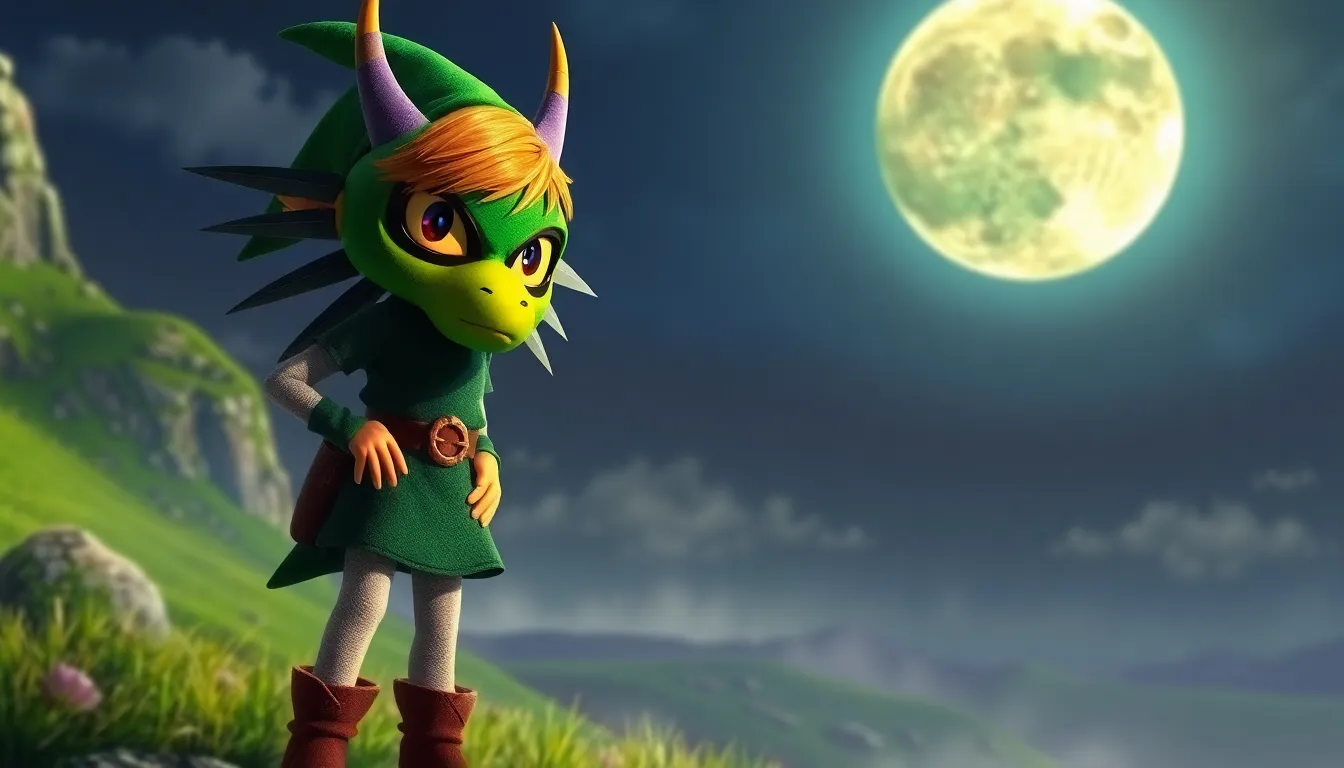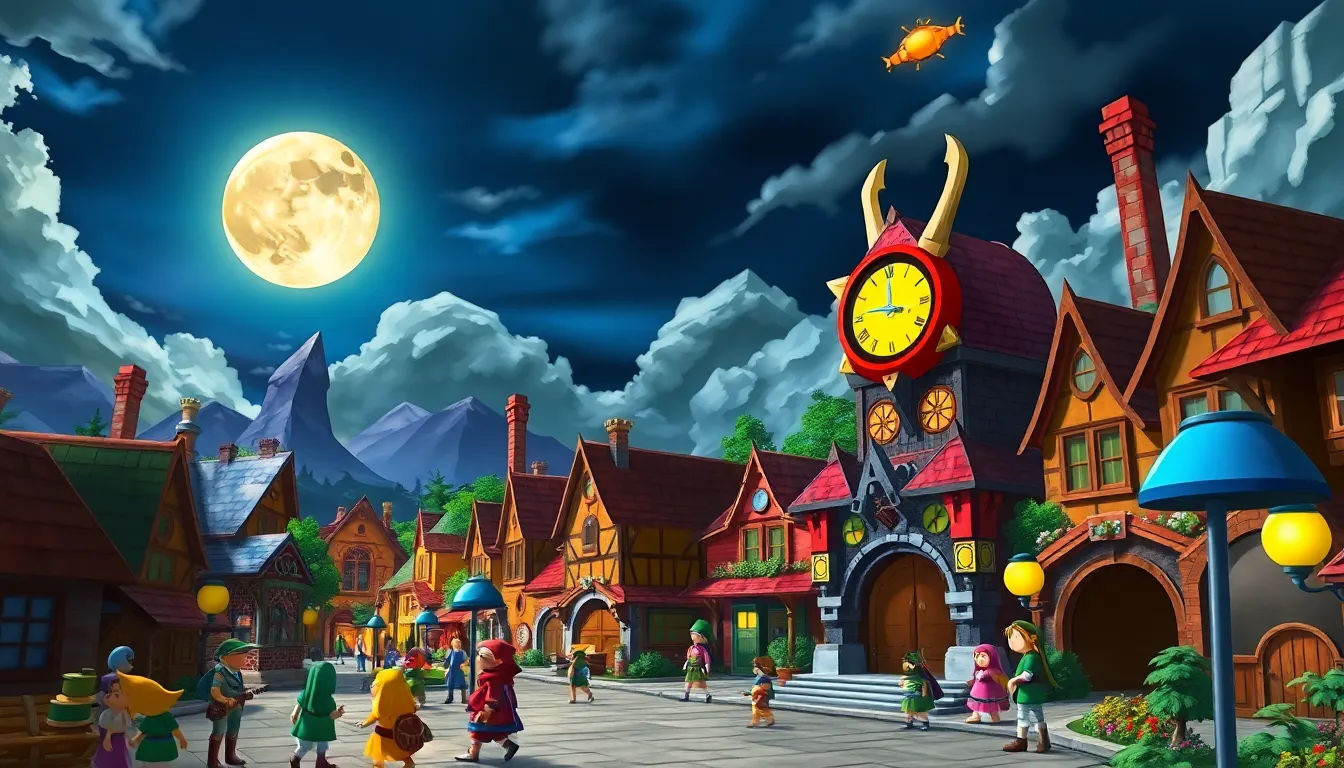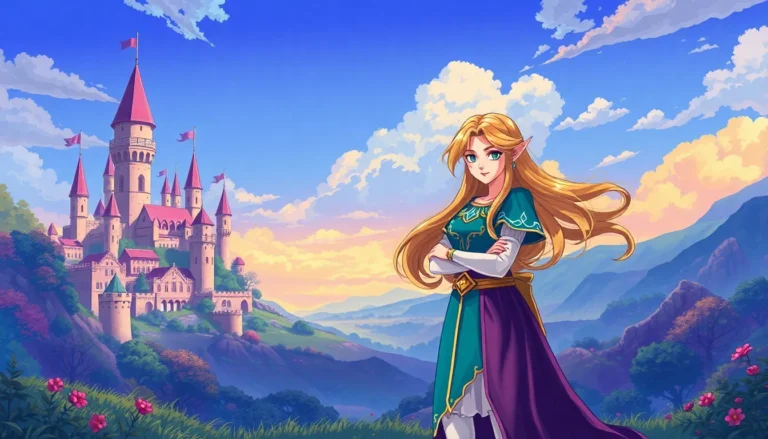In the whimsical world of video games, few titles stand out quite like Zelda: Majora’s Mask. This gem from Nintendo takes players on a wild ride through the land of Termina, where time isn’t just a concept—it’s a ticking clock that can send you spiraling into chaos. Imagine having just three days to save a world on the brink of destruction. Talk about a high-pressure deadline!
With its quirky characters, mind-bending puzzles, and an eerie atmosphere, Majora’s Mask isn’t your typical hero’s journey. It’s a game that challenges players to embrace the bizarre and navigate through a time loop that’ll have them laughing and crying in equal measure. Whether you’re a seasoned gamer or a curious newcomer, this adventure promises to keep you on your toes while you unravel the mysteries of a world that’s both enchanting and downright strange.
Table of Contents
ToggleOverview of Zelda Majora’s Mask
Zelda: Majora’s Mask stands out for its innovative gameplay and gripping narrative. Set in the land of Termina, players confront a looming catastrophic event within three in-game days.
Game Development and Release
Developed by Nintendo EAD, Majora’s Mask debuted on October 26, 2000, for the Nintendo 64. Its creation involved a tight schedule following The Legend of Zelda: Ocarina of Time. The team utilized existing game assets but generated a darker, more intricate storyline. The game’s time-based mechanics added a unique layer, challenging players to manage limited resources effectively. The elaborate world design and intricate character interactions contributed significantly to player immersion. Following its initial release, the game saw re-releases on the GameCube and later on Nintendo 3DS, ensuring consistent fan engagement.
Reception and Legacy
Critics received Majora’s Mask with acclaim, praising its innovative mechanics and atmospheric storytelling. The game holds a Metacritic score of 95, showcasing its strong position in gaming history. Over time, fans have noted its emotional weight and complexity, distinguishing it from other titles in the Zelda franchise. The game influenced several works in the action-adventure genre, encouraging developers to experiment with non-linear gameplay. Its legacy remains evident, evidenced by ongoing discussions and appreciation within gaming communities and its continued relevance in pop culture.
Gameplay Mechanics

Zelda: Majora’s Mask offers distinctive gameplay mechanics that enhance player engagement. Time management and mask transformations play critical roles in the overall experience.
Time-Based System
The time-based system governs the gameplay, providing a unique mechanic that influences every action. Players navigate a repeating three-day cycle, which lasts approximately 54 minutes in real-time. During this limited timeframe, they must complete quests, solve puzzles, and interact with characters to prevent the moon’s impending crash into Termina. Actions like restarting the cycle or using special items, known as the Song of Time, can manipulate time. This mechanic encourages careful planning and exploration, making each decision crucial for progression.
Mask Collecting and Transformation
Mask collecting introduces a dynamic element to character interactions and abilities. Each mask serves a distinct purpose, allowing Link to assume various forms, such as a Deku Scrub or Goron. Collecting a mask enables specific skills, unlocking new paths and gameplay strategies. The transformation aspect adds depth to encounters, with players needing to adapt their approach based on their current form. This mechanic fosters creativity in solving challenges and interacting with the world, enhancing the overall gaming experience.
Story and Setting
Zelda: Majora’s Mask unfolds in the mysterious land of Termina, a realm marked by its unsettling atmosphere and vibrant yet unusual characters. Players navigate a world in peril, facing a harrowing three-day cycle to avert impending doom.
Lore Behind Termina
Termina stands as an alternate universe compared to Hyrule. Mythical deities and folklore intertwine within its lore. Ancient legends suggest that the four regions—Clock Town, Snowhead, Great Bay, and Ikana Valley—are governed by distinct spirits. Each region reflects its unique environmental challenges and cultural traits while contributing to the overarching narrative. The Moon, a symbol of destruction, looms ominously, motivating Link’s quest. Players uncover the rich tapestry of Termina through side quests, connecting events to the larger cosmic fate at hand.
Main Characters and NPCs
Major characters enrich the storyline significantly. Link, the protagonist, embodies courage as he attempts to save Termina. Tatl, a helpful fairy, accompanies Link, offering guidance. Notable NPCs include the enigmatic Skull Kid, who bears the cursed mask, and the four guardians—Deku Princess, a Giant from the Swamp, a Goron from Snowhead, and a Zora from the Great Bay. Each character embodies the emotional depth and intricate storytelling interwoven throughout the game. Side quests allow players to build relationships with these characters, enhancing the immersive experience within Termina’s whimsical yet eerie atmosphere.
Visuals and Sound Design
Zelda: Majora’s Mask showcases an extraordinary visual and audio experience that contributes to its unique atmosphere. The game’s graphics employ a distinctive artistic style that merges whimsical elements with dark themes, creating a compelling contrast throughout Termina.
Artistic Style
Visuals feature a vibrant color palette interspersed with unsettling imagery. Characters appear exaggerated, enhancing their quirks and personalities. Each region within Termina presents a unique aesthetic, from the bustling Clock Town to the desolate Ikana Valley. Design elements draw from various artistic influences, showcasing Nintendo’s creativity. Shadows and lighting amplify the eerie ambiance, immersing players deeper into the game’s narrative. Artists focused on environmental storytelling, enabling players to connect with the world in profound ways. This inventive visual approach helps distinguish Majora’s Mask from other titles in the franchise, reinforcing its lasting impact.
Musical Composition
Sound design plays a vital role in establishing the game’s tone. Composers crafted melodies that resonate with the various moods of the game, successfully complementing its visuals. Each region features thematic scores that reflect its atmosphere, from the cheerful tunes of Clock Town to the haunting echoes of Ikana Valley. Instruments used range from traditional orchestration to unconventional sounds, creating an eclectic mix. Dynamic musical cues respond to gameplay events, guiding player emotions throughout experiences. This interactive music enhances immersion and strengthens emotional connections to characters and settings. Overall, the sound design enriches gameplay, ensuring Majora’s Mask remains memorable.
Impact on Gaming
Zelda: Majora’s Mask significantly influenced the evolution of action-adventure games, showcasing innovative gameplay mechanics that prioritize time management. Its unique approach to storytelling, with an emphasis on character-driven narratives, set a benchmark for future titles. Pioneering the use of real-time mechanics, it created a sense of urgency that captivated players.
Notable for its darker themes, Majora’s Mask diverged from its predecessor, Ocarina of Time, by exploring complex emotional depth. Critics praised its atmospheric design and intricate plot, resulting in a high Metacritic score of 95, reflecting its critical acclaim. Developers took risks by implementing the three-day cycle, allowing players to feel the weight of their choices within Termina.
The mask transformation feature introduced by Majora’s Mask encouraged gameplay experimentation, offering various forms catering to different challenges. Players embraced this gameplay dynamic, enhancing replayability by experimenting with distinct abilities linked to each mask. Fostering creativity, this mechanic established a template for future games emphasizing diverse player experiences.
Culturally, Majora’s Mask achieved lasting recognition within gaming communities, sparking discussions on its themes, mechanics, and influence. The eerie atmosphere and memorable characters continue to resonate with players, making it a frequent topic in pop culture. Game designers routinely reference its mechanics as a source of inspiration, illustrating its impact on game development.
Ultimately, Majora’s Mask serves as a benchmark for immersive gaming experiences, balancing gameplay, narrative depth, and audio-visual elements. Its legacy endures as it continues shaping design philosophies in modern gaming. Developers and players alike regard it as a pivotal piece of gaming history.
Zelda: Majora’s Mask stands as a testament to innovative game design and storytelling. Its unique time-based mechanics and emotional depth create an experience that resonates with players long after the game ends. The enchanting yet eerie world of Termina invites exploration and offers rich narratives through its diverse characters and quests.
This game not only challenges players with its intricate puzzles but also captivates them with its atmospheric visuals and haunting soundscapes. Majora’s Mask has left an indelible mark on the gaming landscape, influencing future titles and continuing to spark discussions among fans. Its legacy as a landmark in action-adventure gaming endures, ensuring its place in the hearts of gamers worldwide.



